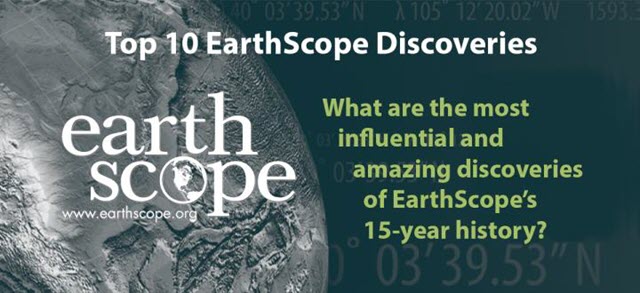EarthScope Announces Top 10 Discoveries List
What are the 10 most influential, revolutionary, unexpected, or just plain amazing discoveries from EarthScope's 15-year history?
 CREDIT EarthScope National Office
CREDIT EarthScope National Office
What are the 10 most influential, revolutionary, unexpected, or just plain amazing discoveries from EarthScope's 15-year history?
"EarthScope has left its mark on earth science in so many ways. We wanted to capture some of the breadth and variety of that legacy with the Top 10 Discoveries list, and we wanted the community to be involved," said Jeff Freymueller, director of the EarthScope National Office from 2015-2019.
EarthScope is a National Science Foundation (NSF) program that has deployed thousands of seismic, GPS, and other geophysical instruments to study the structure and evolution of the North American continent and the processes related to earthquakes and volcanic eruptions. The program involves collaboration between scientists, educators, policy makers, and the public to learn about and apply exciting scientific discoveries as they are made.
The EarthScope program and the EarthScope National Office, charged with communicating EarthScope science and currently housed at the University of Alaska Fairbanks Geophysical Institute, heads into its final year in 2019.
TOP 10 EARTHSCOPE DISCOVERIES
- Background Noise Joins the Toolbelt of Seismology
Pioneered using ambient-noise seismic wavefields for seismic imaging. Combined with other techniques, this provided unprecedented high-resolution images of the crust and upper mantle beneath North America, in which small-scale heterogeneities in the images correlate with geological features. - Pacific Northwest Has a Slow Lane
Tracked slow-slip migration in the Cascadia subduction zone using seismic instruments and GPS stations, clarifying the picture of episodic tremor and slow slip in the region. - Open Data Opens Doors for Students
Provided unique education for a new generation of scientists by providing access to large, open data sets and data products. - Why the San Andreas Fault Rocks
Discovered the internal structure and cause of weakness of the San Andreas Fault from the San Andreas Fault Observatory at Depth (SAFOD) rock core samples. - North America Is under Pressure
Demonstrated that the entire North American continent is deforming due to a combination of tectonics and changes in surface loads (water and ice). - Tracking North America's Hidden Past
Imaged new slabs of the ancient Farallon plate and its predecessors, following the trail in the mantle of the plate breaking up under North America, showing it extends from the Pacific Coast subduction zone to the eastern part of the continent. - GPS Warnings
Learned GPS stations could provide effective early hazard warnings: station movements can be used to estimate earthquake magnitude in real time, similar to seismometers, to provide immediate alerts; and GPS signals can track a tsunami as the wave compresses the atmosphere above it, allowing time for an alert. - The Ups and Downs of Drought
Discovered methods of using GPS to detect changes in groundwater from observed vertical crustal movements in the shallow subsurface. - Backtracking to Global Breakups
Developed and applied high-resolution seismic source back-projection for imaging the rupture dynamics of large global earthquakes. - Laser Vision to See Earthquake Damage
Pioneered before-and-after lidar techniques to measure earthquake displacements from the El Mayor-Cucapah earthquake.
The EarthScope National Office asked EarthScope leaders, past and present, to submit several ideas each about what they considered to be the program's top discoveries and science contributions. Current and former directors, steering committee members, synthesis workshop leaders, and longtime partners all listed ideas for the ballot. Scientists, students, and educators in the EarthScope community then had the opportunity to vote for 10 items from the list, or to write in an idea or two.
The EarthScope National Office booth (#512) will display the Top 10 Discoveries with their full descriptions. Freymueller will give the presentation "EarthScope: Lessons from a Massive Science Endeavor" on Friday, February 15, 1:30 p.m. at the first of two EarthScope sessions.
